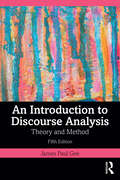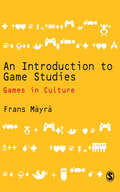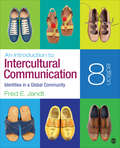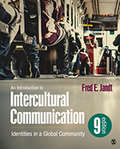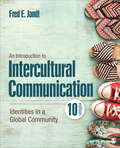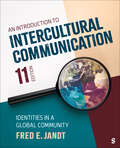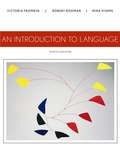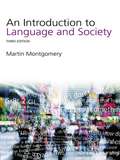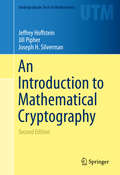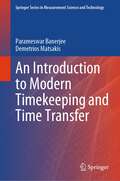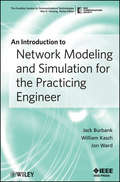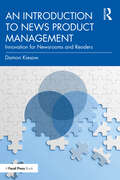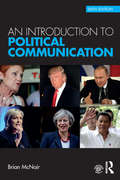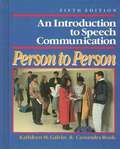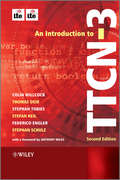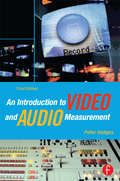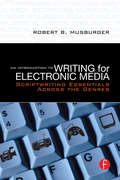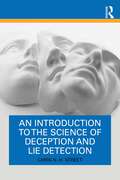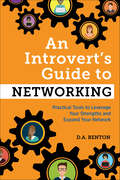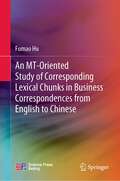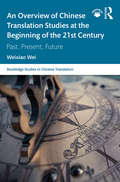- Table View
- List View
An Introduction to Discourse Analysis: Theory and Method
by James Paul GeeThis bestselling textbook provides a comprehensive guide to conducting discourse analysis. The book outlines Gee’s approach, which involves examining how language is used in context to construct meaning, identities, relationships, and social practices.The theoretical framework is built around seven "building tasks" that language performs: significance, practices, identities, relationships, politics, connections, and sign systems and knowledge. Gee introduces six "tools of inquiry" for analyzing these tasks: situated meanings, social languages, figured worlds, intertextuality, Discourses, and Conversations.Methodologically, Gee emphasizes the importance of context and the reciprocal relationship between language and context. He discusses transcription, outlines the components of an "ideal" discourse analysis, and addresses issues of validity.The book provides practical guidance on analyzing various aspects of language, such as intonation units, stanzas, and the overall organization of oral and written texts. Gee uses interview data to demonstrate how identities and socially situated meanings are constructed through language.This new edition is updated throughout with new examples and a new chapter on multimodal discourse analysis, demonstrating how Gee’s approach can be applied to texts that combine language with other modes of communication, like images or video. Overall, the book equips readers with a robust toolkit for systematically analyzing discourse.
An Introduction to Game Studies
by Frans MayraAn Introduction to Game Studies is the first introductory textbook for students of game studies. It provides a conceptual overview of the cultural, social and economic significance of computer and video games and traces the history of game culture and the emergence of game studies as a field of research. Key concepts and theories are illustrated with discussion of games taken from different historical phases of game culture. Progressing from the simple, yet engaging gameplay of Pong and text-based adventure games to the complex virtual worlds of contemporary online games, the book guides students towards analytical appreciation and critical engagement with gaming and game studies. Students will learn to: - Understand and analyse different aspects of phenomena we recognise as 'game' and play' - Identify the key developments in digital game design through discussion of action in games of the 1970s, fiction and adventure in games of the 1980s, three-dimensionality in games of the 1990s, and social aspects of gameplay in contemporary online games - Understand games as dynamic systems of meaning-making - Interpret the context of games as 'culture' and subculture - Analyse the relationship between technology and interactivity and between 'game' and 'reality' - Situate games within the context of digital culture and the information society With further reading suggestions, images, exercises, online resources and a whole chapter devoted to preparing students to do their own game studies project, An Introduction to Game Studies is the complete toolkit for all students pursuing the study of games. The companion website at www.sagepub.co.uk/mayra contains slides and assignments that are suitable for self-study as well as for classroom use. Students will also benefit from online resources at www.gamestudiesbook.net, which will be regularly blogged and updated by the author. Professor Frans Mäyrä is a Professor of Games Studies and Digital Culture at the Hypermedia Laboratory in the University of Tampere, Finland.
An Introduction to Intercultural Communication: Identities in a Global Community
by Fred E. JandtAn Introduction to Intercultural Communication: Identities in a Global Community prepares today’s students to successfully navigate our increasingly global community. Fred E. Jandt introduces essential communication skills and concepts that will empower readers to interact successfully with different cultures and ethnic groups. To spark student interest, Jandt offers readers unique insights into intercultural communication, at home and abroad, through an emphasis on history, culture, and popular media. Each chapter integrates material on social media, as well as extensive new examples from recent international news and events. Throughout the text, Jandt reinforces the important roles that stories, personal experiences, and self-reflection play in building our intercultural understanding and competence. The Eighth Edition adds depth to the coverage of theory and includes two new features: Focus on Skills provides expanded coverage of intercultural communication in practice, while Focus on Technology illustrates the impact of new communication technology on intercultural encounters. The new edition also introduces a new map program to provide students with additional context for discussion of cultures and regions across the globe.
An Introduction to Intercultural Communication: Identities in a Global Community
by Fred E. Jandt“One of the best textbooks in intercultural communication for undergraduate students” —Mo Bahk, California State University, San Bernardino How does the Syrian refugee crisis, the election of Donald Trump, and the increasing number of “walls” being built to control immigration affect our ability to communicate and function across cultures? The highly anticipated Ninth Edition of An Introduction to Intercultural Communication prepares today’s students to successfully navigate our increasingly global community by integrating major current events into essential communication skills and concepts. To spark student interest, award-winning professor and best-selling author Fred E. Jandt offers unique insights into intercultural communication, at home and abroad, through an emphasis on history, culture, and popular media. Each chapter integrates material on social media, as well as extensive new examples from recent international news and events. Throughout the text, Jandt reinforces the important roles that our own stories, personal experiences, and self-reflection play in building our intercultural understanding and competence. New to the Ninth Edition New material on religion and identity, gender identity, and gender expression enables readers to explore the most current coverage on modern theories. Focus on Skills boxes have been expanded to include more activities that provide students with additional practice of intercultural communication skills. Focus on Technology boxes illustrate the impact of the newest communication technology on intercultural encounters. The popular map program provide students with additional context for discussion of cultures and regions across the globe and dynamic data displays that are popular with students. Give your students the SAGE edge! SAGE edge offers a robust online environment featuring an impressive array of free tools and resources for review, study, and further exploration, keeping both instructors and students on the cutting edge of teaching and learning. Learn more at edge.sagepub.com/jandt9e
An Introduction to Intercultural Communication: Identities in a Global Community
by Fred E. Jandt“One of the best textbooks in intercultural communication for undergraduate students” —Mo Bahk, California State University, San Bernardino How does the Syrian refugee crisis, the election of Donald Trump, and the increasing number of “walls” being built to control immigration affect our ability to communicate and function across cultures? The highly anticipated Ninth Edition of An Introduction to Intercultural Communication prepares today’s students to successfully navigate our increasingly global community by integrating major current events into essential communication skills and concepts. To spark student interest, award-winning professor and best-selling author Fred E. Jandt offers unique insights into intercultural communication, at home and abroad, through an emphasis on history, culture, and popular media. Each chapter integrates material on social media, as well as extensive new examples from recent international news and events. Throughout the text, Jandt reinforces the important roles that our own stories, personal experiences, and self-reflection play in building our intercultural understanding and competence. New to the Ninth Edition New material on religion and identity, gender identity, and gender expression enables readers to explore the most current coverage on modern theories. Focus on Skills boxes have been expanded to include more activities that provide students with additional practice of intercultural communication skills. Focus on Technology boxes illustrate the impact of the newest communication technology on intercultural encounters. The popular map program provide students with additional context for discussion of cultures and regions across the globe and dynamic data displays that are popular with students. Give your students the SAGE edge! SAGE edge offers a robust online environment featuring an impressive array of free tools and resources for review, study, and further exploration, keeping both instructors and students on the cutting edge of teaching and learning. Learn more at edge.sagepub.com/jandt9e
An Introduction to Intercultural Communication: Identities in a Global Community
by Fred E. JandtAn Introduction to Intercultural Communication equips students with the knowledge and skills to be competent and confident intercultural communicators. Best-selling author Fred E. Jandt guides readers through key concepts and helps them connect intercultural competence to their own life experiences in order to enhance understanding. Employing his signature accessible writing style, Jandt presents balanced, up-to-date content in a way that readers find interesting and thought-provoking. The Tenth Edition gives increased attention to contemporary social issues in today’s global community such as gender identifications, social class identity, and immigration and refugees. Included with this title: The password-protected Instructor Resource Site (formally known as SAGE Edge) offers access to all text-specific resources, including a test bank and editable, chapter-specific PowerPoint® slides.
An Introduction to Intercultural Communication: Identities in a Global Community
by Fred E. JandtAn Introduction to Intercultural Communication equips students with the knowledge and skills to be competent and confident intercultural communicators. Best-selling author Fred E. Jandt guides readers through key concepts and helps them connect intercultural competence to their own life experiences in order to enhance understanding. Employing his signature accessible writing style, Jandt presents balanced, up-to-date content in a way that readers find interesting and thought-provoking. The Tenth Edition gives increased attention to contemporary social issues in today’s global community such as gender identifications, social class identity, and immigration and refugees. Included with this title: The password-protected Instructor Resource Site (formally known as SAGE Edge) offers access to all text-specific resources, including a test bank and editable, chapter-specific PowerPoint® slides.
An Introduction to Intercultural Communication: Identities in a Global Community
by Fred E. JandtAn Introduction to Intercultural Communication prepares students to successfully navigate our increasingly interconnected global community by introducing essential communication skills and concepts with the goal of cultivating intercultural communication competencies when interacting with different cultures and ethnic groups. Best-selling author Fred E. Jandt offers students unique insights into intercultural communication, at home and abroad, through a focus on history, culture, and popular media. Emphasis is also placed on the important roles that stories, personal experiences, and self-reflection play in building our intercultural understanding and competence. The Eleventh Edition presents the most extensive revision of the text, including tying chapter learning objectives to the content, a new "Point/Counterpoint" feature to present both sides of controversial issues in intercultural communication to aid in developing critical thinking skills, and current examples that speak to the changing dynamics of our global community.
An Introduction to Intercultural Communication: Identities in a Global Community
by Fred E. JandtAn Introduction to Intercultural Communication prepares students to successfully navigate our increasingly interconnected global community by introducing essential communication skills and concepts with the goal of cultivating intercultural communication competencies when interacting with different cultures and ethnic groups. Best-selling author Fred E. Jandt offers students unique insights into intercultural communication, at home and abroad, through a focus on history, culture, and popular media. Emphasis is also placed on the important roles that stories, personal experiences, and self-reflection play in building our intercultural understanding and competence. The Eleventh Edition presents the most extensive revision of the text, including tying chapter learning objectives to the content, a new "Point/Counterpoint" feature to present both sides of controversial issues in intercultural communication to aid in developing critical thinking skills, and current examples that speak to the changing dynamics of our global community.
An Introduction to Intercultural Communication: Identities in a Global Community (Eighth Edition)
by Fred E. Edmund JandtAn Introduction to Intercultural Communication: Identities in a Global Community prepares today's students to successfully navigate our increasingly global community. Fred E. Jandt introduces essential communication skills and concepts that will empower readers to interact successfully with different cultures and ethnic groups. To spark student interest, Jandt offers readers unique insights into intercultural communication, at home and abroad, through an emphasis on history, culture, and popular media. Each chapter integrates material on social media, as well as extensive new examples from recent international news and events. Throughout the text, Jandt reinforces the important roles that stories, personal experiences, and self-reflection play in building our intercultural understanding and competence. The Eighth Edition adds depth to the coverage of theory and includes two new features: Focus on Skills provides expanded coverage of intercultural communication in practice, while Focus on Technology illustrates the impact of new communication technology on intercultural encounters. The new edition also introduces a new map program to provide students with additional context for discussion of cultures and regions across the globe.
An Introduction to Language
by Victoria Fromkin Robert Rodman Nina HyamsAssuming no prior knowledge of linguistics, AN INTRODUCTION TO LANGUAGE, Tenth Edition, is appropriate for a variety of fields--including education, languages, psychology, cognitive science, anthropology, English, and teaching English as a Second Language (TESL)--at both the undergraduate and graduate levels. This completely updated edition retains the clear descriptions, humor, and seamless pedagogy that have made the book a perennial best-seller, while adding new information and exercises that render each topic fresh, engaging, and current.
An Introduction to Language and Society (Studies In Culture And Communication Ser.)
by Martin MontgomeryIn this third edition of the bestselling classic textbook, Martin Montgomery explores the key connections between language and social life. Guiding the student through discussions on child language, accent and dialect, social class and gender, as well as a number of other topics, Montgomery provides a comprehensive and accessible introduction to the function of language in modern society. This third edition includes: new sections on dialect levelling and estuary English; hip-hop and rapping as anti-language and ‘crossing’ between Creole, Panjabi and South Asian English new material on the Gulf War and the 'War on Terror' discussions on language in internet usage and new technologies updated examples and references. With detailed suggestions for further reading and practical work for each chapter, An Introduction to Language and Society is the ideal resource for students and teachers of Communication Studies and Language Studies.
An Introduction to Mathematical Cryptography (Undergraduate Texts in Mathematics)
by Joseph H. Silverman Jeffrey Hoffstein Jill PipherThis self-contained introduction to modern cryptography emphasizes the mathematics behind the theory of public key cryptosystems and digital signature schemes. The book focuses on these key topics while developing the mathematical tools needed for the construction and security analysis of diverse cryptosystems. Only basic linear algebra is required of the reader; techniques from algebra, number theory, and probability are introduced and developed as required. This text provides an ideal introduction for mathematics and computer science students to the mathematical foundations of modern cryptography. The book includes an extensive bibliography and index; supplementary materials are available online. The book covers a variety of topics that are considered central to mathematical cryptography. Key topics include: classical cryptographic constructions, such as Diffie-Hellmann key exchange, discrete logarithm-based cryptosystems, the RSA cryptosystem, and digital signatures; fundamental mathematical tools for cryptography, including primality testing, factorization algorithms, probability theory, information theory, and collision algorithms; an in-depth treatment of important cryptographic innovations, such as elliptic curves, elliptic curve and pairing-based cryptography, lattices, lattice-based cryptography, and the NTRU cryptosystem. The second edition of An Introduction to Mathematical Cryptography includes a significant revision of the material on digital signatures, including an earlier introduction to RSA, Elgamal, and DSA signatures, and new material on lattice-based signatures and rejection sampling. Many sections have been rewritten or expanded for clarity, especially in the chapters on information theory, elliptic curves, and lattices, and the chapter of additional topics has been expanded to include sections on digital cash and homomorphic encryption. Numerous new exercises have been included.
An Introduction to Modern Timekeeping and Time Transfer (Springer Series in Measurement Science and Technology)
by Parameswar Banerjee Demetrios MatsakisThis book provides a comprehensive, systematic description of modern timekeeping and its specializations. Introductory chapters discuss the concept of time and its definition, then briefly look at pre-Atomic Era timekeeping to set the stage for the introduction of the atomic clock. Subsequent chapters focus on concepts such as frequency stability and measurement uncertainty, as well as computer network time-synchronization protocols including Network Time Protocol (NTP) and Precise Time Protocol (PTP). The book then delves into the nuts and bolts of the Global Navigation Satellite Systems (GNSS), Two-Way Satellite Time and Frequency Transfer, and Optical Time and Frequency Transfer. Timescale theory is then described as a way to combine clock data, and the algorithms and procedures used to generate Coordinated Universal Time (UTC) are given. Finally, there is a look at modern applications of timekeeping and time transfer.Featuring a glossary of all key terms, this book is highly recommended for trained or incoming physicists, engineers, or mathematicians working, for example, in manufacturing or timing laboratories. Additionally, it is suitable for use in introductory university courses dealing with the subject of timekeeping.
An Introduction to Network Modeling and Simulation for the Practicing Engineer (The ComSoc Guides to Communications Technologies #5)
by Jon Ward Jack L. Burbank William KaschThis book provides the practicing engineer with a concise listing of commercial and open-source modeling and simulation tools currently available including examples of implementing those tools for solving specific Modeling and Simulation examples. Instead of focusing on the underlying theory of Modeling and Simulation and fundamental building blocks for custom simulations, this book compares platforms used in practice, and gives rules enabling the practicing engineer to utilize available Modeling and Simulation tools. This book will contain insights regarding common pitfalls in network Modeling and Simulation and practical methods for working engineers.
An Introduction to News Product Management: Innovation for Newsrooms and Readers
by Damon KiesowDrawing on innovations in the business of journalism, this book offers a comprehensive guide to using the human-centred design methods of product management to serve readers and bolster digital success in news organizations. An Introduction to News Product Management sets out how “product thinking” should be used in news organizations and practiced in accordance with journalistic ethics and customs. Beginning by looking at the history and theory behind the profession, this book builds a foundational understanding of what product management is and why news is a unique product. In the second unit, the author discusses how the human-centred design philosophy of product management aligns with the mission and ethics of journalism, and how that influences the view of audiences and frames strategies. The third unit of the book focuses on the daily use of product management in news organizations, providing students with a guide to its use in researching, prioritizing, and building sustainable projects that deliver news to readers and viewers. Written in an accessible style, this book features input from industry experts and draws on global examples to provide practical guidance. This is an ideal text for advanced undergraduates and graduates studying entrepreneurial journalism, media innovation, and digital media economics, as well as media professionals keen to learn more about product management and human-centred design methods.
An Introduction to Political Communication (Communication and Society #5)
by Brian McNairAt a time of radical shifts in power across the globe, the sixth edition of An Introduction to Political Communication examines the role of the media in the political process. Brian McNair reflects on the role of communication in key events such as the referendum vote for the UK’s withdrawal from the European Union, the rise of nationalist populism in Europe, and the victory of Donald Trump in the 2016 US presidential election. He explores the use of communication as a weapon by Islamic State and other insurgent organisations, and by Putin’s Russia in its dealings with the West, including the hacking of Democratic Party emails in 2016. McNair argues that an expanding globalised public sphere and digital media network have transformed political communication, allowing political actors, from politicians and pressure groups to trade unions and terrorist organisations, to bypass traditional, established media in communicating their messages. This sixth edition of McNair’s classic text has been comprehensively revised and updated to include: the 2016 US presidential election and Donald Trump’s rise to power; the UK’s EU referendum of 2016, the Scottish independence referendum of 2014 and the ‘snap’ UK general election of June 2017; the growing role in political communication of the internet and social media platforms such as Twitter, Facebook and YouTube, and their destabilising impact on the management of political crises all over the world including the shooting down of Malaysian Airlines MH17 and the disappearance of MH370, the Tianjin disaster in China and the Russian intervention in Ukraine; Islamic State’s global jihad, and the use of social media as an instrument of terror; the growing capacity of WikiLeaks and other online sources, such as the International Consortium of Investigative Journalists, to challenge elite control of information.
An Introduction to Speech Communication: Person to Person (5th edition)
by Kathleen M. Galvin Cassandra BookThis Fifth Edition comprises eight units and contains topics on communication such as The Communication Process and Inventories, Speaking and Listening, Self as Communicator, Interpersonal Communication, Group Communication, Public Communication, Persuasive Communication and Media Communication.
An Introduction to TTCN-3
by Colin Willcock Thomas Deiß Stephan Tobies Federico Engler Anthony Wiles Stefan Keil Stephan SchulzThis unique book provides a fully revised and up-to-date treatment of the TTCN-3 language TTCN-3 is an internationally standardised test language with a powerful textual syntax which has established itself as a global, universal testing language. Application of TTCN-3 has been widened beyond telecommunication systems to areas such as the automotive industry, internet protocols, railway signalling, medical systems, and avionics.An Introduction to TTCN-3 gives a solid introduction to the TTCN-3 language and its uses, guiding readers though the TTCN-3 standards, methodologies and tools with examples and advice based on the authors' extensive real-world experience. All the important concepts and constructs of the language are explained in a step-by-step, tutorial style, and the authors relate the testing language to the overall test system implementation, giving the bigger picture.This second edition of the book has been updated and revised to cover the additions, changes and extensions to the TTCN-3 language since the first version was published. In addition, this book provides new material on the use of XML, test framework design and LTE testing with TTCN-3.Key Features:Provides a fully revised and up-to-date look at the TTCN-3 language Addresses language standardization, tool implementation and applying TTCN-3 in real world scenarios such as VoIP and LTE testing Explores recent advances such as TTCN-3 core language extensions on type parameterization, behavior types, real time and performance testing Introduces the use of ASN.1 and XML with TTCN-3 Written by experts in the field Includes an accompanying website containing code samples and links to the relevant standards documents (www.wiley.com/go/willcock_ttcn-3_2e) This book is an ideal reference for test engineers, software developers, and standards professionals. Graduate students studying telecommunications and software engineering will also find this book insightful.
An Introduction to Video and Audio Measurement
by Peter HodgesWhat do we measure and why? Peter Hodges explains the answer to this question in approachable language and with clear illustrations. Newcomers to the video industry, as well as those already established, will find this uniquely readable guide to the basics of a complex subject. Building on the success of the two previous editions of this popular title and covering both analog and digital video, the third edition includes new sections on audio measurement, high definition video, and innovative techniques of test and measurement.
An Introduction to Writing for Electronic Media: Scriptwriting Essentials Across the Genres
by Robert B. MusburgerLearn what it takes to write for commercials, news, documentaries, corporate, educational, animation, games, the internet, and dramatic film & video productions * Outlines the key skills needed for a successful media writing career The demand for quality and knowledgeable multi-platform writing is always in high demand. An Introduction to Writing for Electronic Media presents a survey of the many types of electronic media you can write for, and explains how to do it. Musburger focuses on the skills you need to write for animation versus radio or television news versus corporate training. Sample scripts help you learn by example while modeling your own scripts. Production files illustrate the integral role writers' play in the production process, and individual movie frames allow you compare these to the real scripts. Armed with the skills developed in this book, a media writer can apply for a variety of positions in newsrooms, advertising firms, motion pictures or animation studios, as well as local and national cable operations. Robert B. Musburger, Ph.D., is Professor Emeritus and former Director of the School of Communication, University of Houston, USA. He has worked for 20 years in professional broadcasting, serving as camera operator, director, producer, and writer. Musburger has received numerous awards for his video work and teaching and he continues to work in electronic media with his Seattle, WA,. consulting firm, Musburger Media Services.
An Introduction to the Science of Deception and Lie Detection
by Chris N. StreetThis accessible book provides a foundational understanding of the science of deception and lie detection. Focusing on core issues for the field, it discusses classic and current psychological research into lying as well as theoretical approaches to understanding human lie detection. This book explores engaging questions around how people lie, how people make decisions about believing others, and how we can detect deception. Each chapter is clearly structured to support students of all levels by summarising content, presenting key research, and systematically evaluating findings. Chapters explore topics including some of the most promising current lie detection techniques, how and why people lie, how lying develops in children, and whether unconscious thinking can boost lie detection accuracy. Providing an overview of key issues in deception, this book will be of great interest to students and lecturers in the field of deception and lie detection, as well as anyone generally interested in this fascinating field of research.
An Introvert's Guide to Networking: Practical Tools to Leverage Your Strengths and Expand Your Network
by D A BentonEncouraging and practical advice to help introverts improve their networking skillsProfessional networking can seem overwhelming, especially if you're introverted in social situations. An Introvert's Guide to Networking is here to make it easier, with everyday advice that helps you leverage your natural strengths like listening, observation, and careful thought, to create connections in ways that feel comfortable and genuine for you.An Introvert's Guide to Networking offers:Helpful, hands-on guidance—Learn networking tips like how to enter (and exit) conversations gracefully, optimize your social media presence, be aware of your body language, and more.Advice for everyone—These inclusive techniques are helpful for people of all career stages, industries, and social skill levels—even extroverts might learn a thing or two.Real examples—Read quotes and anecdotes from introverts who've used their authentic personalities to make successful professional relationships.Start networking more productively today with a book that makes it easier for introverts.
An MT-Oriented Study of Corresponding Lexical Chunks in Business Correspondences from English to Chinese
by Fumao HuThis book sheds new light on chunk in business correspondence in order to promote the advancement of machine translation. By presenting a bilingual chunk table for correspondence and providing basic theoretical and empirical data on the construction of an MT-based English-Chinese chunk bank for business correspondence, it seeks to improve the accuracy of machine translation systems in a new way. It mainly addresses two questions: (1) How can business English correspondence chunks be defined in machine translation? (2) What are the correspondences between English-Chinese business letter chunks for machine translation? With the aid of a parallel corpus, qualitative and quantitative research methods, and the construction grammar theory, the book puts forward a theoretical model of chunk composition analysis. Further, the findings presented here can be used for the machine translation of English-Chinese business letters, helping to break down communication barriers and promote international business and exchanges.
An Overview of Chinese Translation Studies at the Beginning of the 21st Century: Past, Present, Future (Routledge Studies in Chinese Translation)
by Weixiao WeiAn Overview of Chinese Translation Studies at the Beginning of the 21st Century presents and analyses over 100,000 bibliographic notes contained within a large academic database focusing on translation within China. Exploring Chinese translation studies two decades before and after the year 2000, the book will introduce aspects of theory, culture, strategy, register, genre, and context to the field of translation in China, and will also take into account the impact of technology, education, and research within this field. Aimed at postgraduate students and researchers of translation studies, the focus of An Overview of Chinese Translation Studies at the Beginning of the 21st Century is the theory and practice of translation studies within a fast-paced and growing academic discipline.
